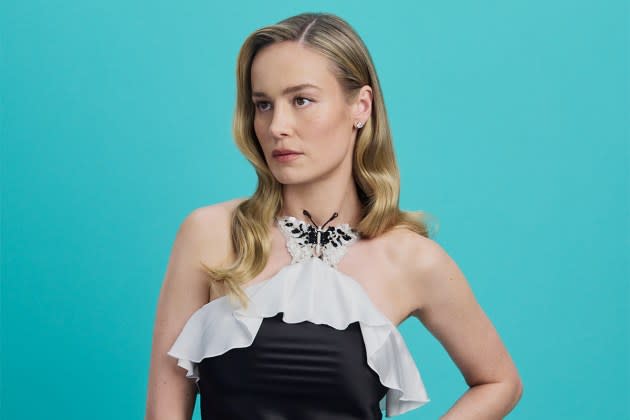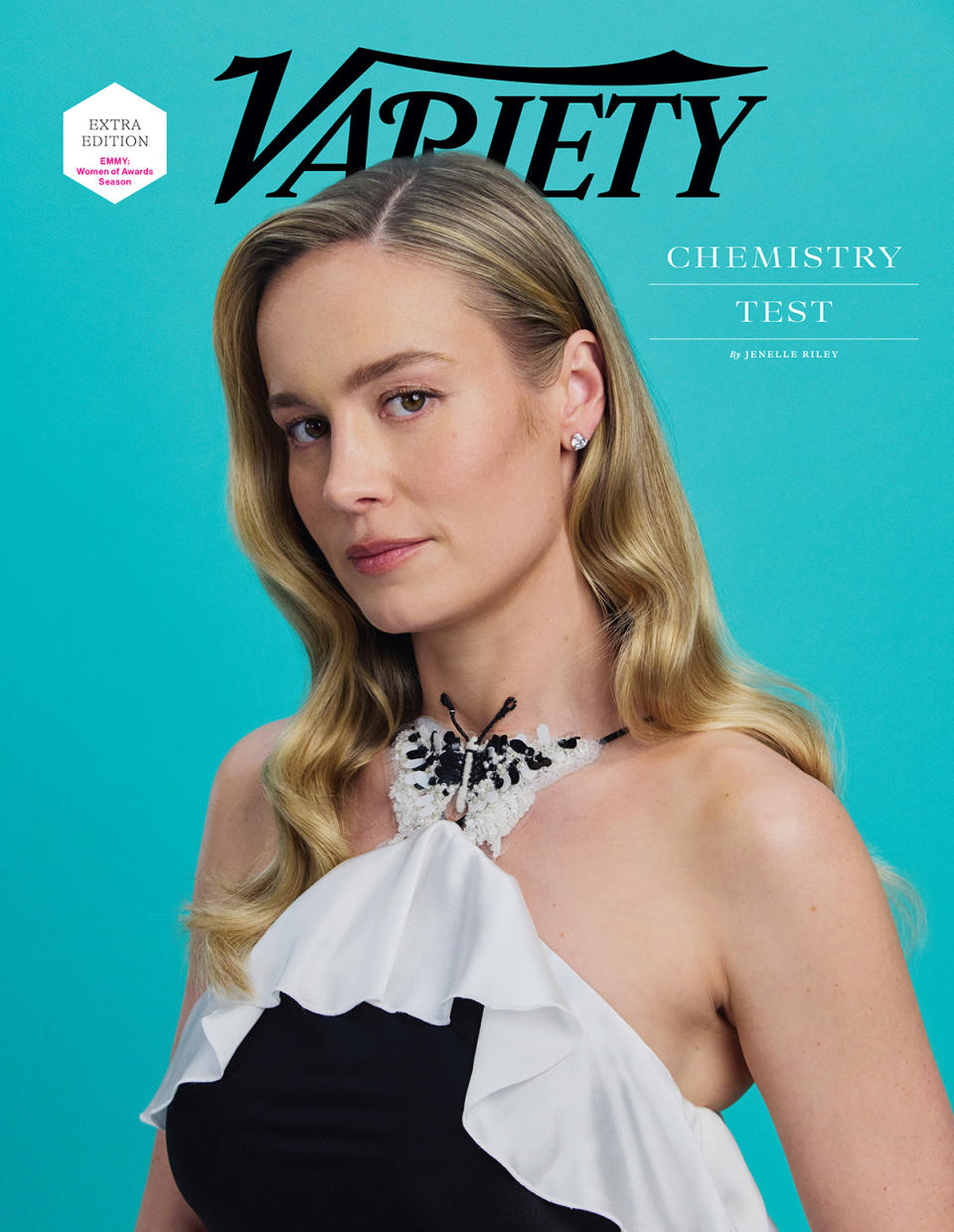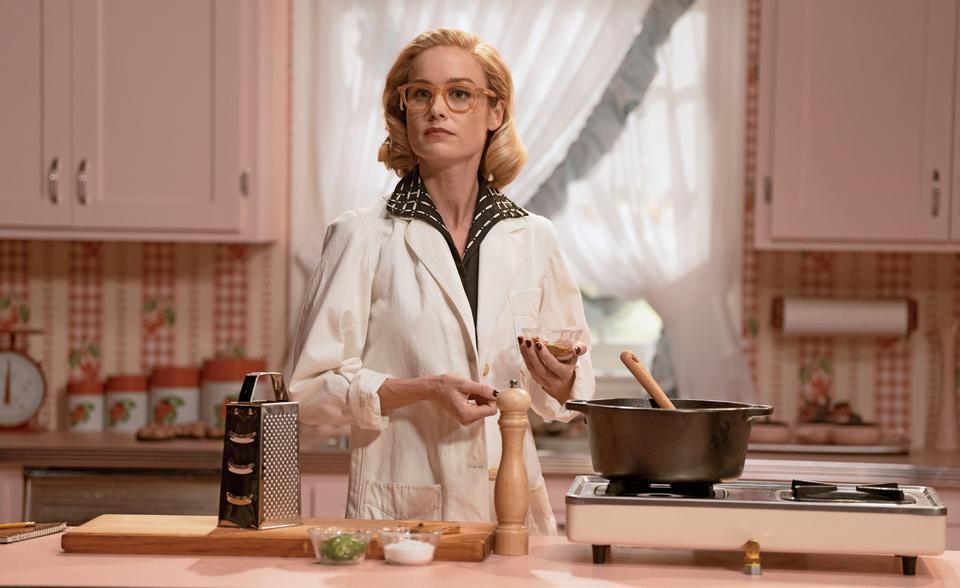‘Lessons in Chemistry’: Brie Larson Says Falling in Love Is Harder Than It Looks on Screen: ‘It’s So Nuanced’

Brie Larson showed up to the “Lessons in Chemistry” set ready to play — both figuratively and literally. The Oscar-winner brought with her two huge storage bins filled with games she’d haul to every location.
“I started doing it when I was filming ‘The Marvels’ during the pandemic,” Larson reveals. “We were in bubbles and didn’t have the nor- mal situation where the actors could hang out together and bond. So, my bubble would play games to pass the time.”
More from Variety
She then brought the party to the set of the Apple TV+ limited series, which she also executive produced. Based on the bestselling novel by Bonnie Garmus, “Lessons in Chemistry” tells the story of Elizabeth Zott, a brilliant chemist who ends up hosting a 1960s cooking show, which she uses to educate housewives on more than just meal preparation.
There’s a method to Larson’s game choices; card games like Uno and Go Fetch (essentially, Go Fish with dogs) are simple and “don’t take up a lot of brain space” on days that might prove challenging. “If you have a really heavy, dark scene, it’s nice to then be asking if anyone has a dog named Cinnamon for you,” she reasons.
Prior to laboratory scenes, she found word games and puzzles helped “keep up the pace and energy” and prime her mind for the scientific speak. If more kids were on the set, she would break out Spot It!, which is family-friendly and good for large groups. And she and co-star Lewis Pullman, who plays Elizabeth’s love interest, Calvin Evans, bonded over the guessing game Codenames. “It’s a great way to connect, to make eye contact with people and to laugh and be vulnerable but doesn’t involve asking personal questions.”

Aja Naomi King, who plays Elizabeth’s confidante, Harriet Sloane, in a role greatly expanded from the book, echoes, “It was a great way to engage with each other and connect and tell stories or make jokes. It made the connection onscreen feel that much more real and relaxed. I loved that experience so much because it reminded us all just how lucky we were and how to savor the fun of creating this little bit of magic onscreen.”
And the levity was welcome, considering some of the emotional territory Larson found herself navigating in the series’ eight episodes. A woman ahead of her time, Elizabeth is scorned and even assaulted by her male counterparts. After losing Calvin, she raises their daughter, Madeline (Alice Halsey) as a single mother. Her makeshift family includes a lovable dog named Six-Thirty and Harriet, who is fighting her own battles as a Black female activist. While she inspires countless women as the host of “Supper at Six,” it comes at a cost as she fights constant battles with the network and sponsors.
Executive producer Lee Eisenberg developed the adaptation and penned several of the episodes knowing it was a tall order. “The role was incredi- bly demanding: She had to be a brilliant chemist, an excellent chef and a highly competitive rower,” he says. “We threw her three-page monologues about DNA. She had to act opposite a dog in one of the most moving episodes I’ve ever had the privilege to write.”
And Larson delivered. “Her performance exceeded my expectations from scene to scene,” Eisenberg notes. “And she really builds a community on set. Like Elizabeth, she sees the best in everyone and fosters an environment where everyone is rising to the occasion.”
If he has one quibble, it’s minor: “Honestly, my only note I could give Brie is that she needs to polish up her Boggle skills.”
Larson calls Eisenberg a “dream collaborator” and jokes how they would go back and forth about certain issues. “We would fight about things. I would send him emojis of gravestones and be like, ‘I’m gonna die on this hill,’” she recalls. “And he’d say, ‘I’ll leave flowers on your grave, you’re wrong.’”
She adds, “He would be the first person to say, ‘Wow, I was wrong; you were right.’”
Though many like to talk about disagreements as if they’re a bad thing, most creatives know it’s a necessary part of filmmaking. “It actually feels quite freeing to be able to know you’re allowed to disagree with somebody and not lose love or respect,” Larson says. “One of the great pleasures of being in a medium that is a collaborative team sport is that sometimes you’re not going to be on the same page and you’re able to figure it out. And a lot of times, it ends up being one part of your idea and one part of their idea, and it’s a new idea that is better than you could have imagined.”

Larson adds that both starring and taking on an executive producer role was not only personally rewarding, but helpful to the atmosphere on set. “I was kind of this bridge between both worlds,” she says. “Most people talk about cast and crew, which I think is a silly way of grouping things. I think it’s just crew. And because I work on both sides, I was accommodating on both sides.”
King, for one, noticed and appreciated the communal atmosphere. “Brie was utterly wonderful to work alongside,” she says. “She is incredibly generous as an actor and made the entire set environment feel like one big family.”
One of the factors Larson felt most passionate about was accurately representing the love story between Elizabeth and Calvin. Though she’s had love interests onscreen before, Larson had never really been at the center of a love story. It was one of the main things that appealed to her about the book. “I don’t know if I could ever get enough of watching what it’s like to be loved and to love on screen and all the different ways that can happen,” she says. “The show has all these bumps to it but, to me, it’s about loving and being deeply loved and how it’s an unstoppable force.”
And it’s not just the romantic relationship but Elizabeth’s love for her friends, her child and even her audience. “You can be astounded by how much you love and how remarkable it is that we continue to after the amount of hurt we’ve sustained,” she says.
It was important to her that the show avoid tradi- tional tropes and have its characters remain true to themselves — to not make decisions that would go against their intellect. “There were a lot of conversa- tions about what does it look like to fall in love and what it looks like when your walls start to fall down,” she reveals. “You’re never going to get a consensus on that. But that’s the fun part of the dance.”
Larson adds that one of the few times she would go to a monitor and check her work was during the early scenes between Elizabeth and Calvin. “The two things that I think are so complicated to show are falling in love and lying,” she says. “It’s so nuanced and there are so many things happening at once.”
Also a challenge for the actor was the idea of doing less — Elizabeth is extremely restrained, even when dealing with tragedy. Larson recalls looking forward to shooting the third episode, after her character loses Calvin. “I was like, ‘Oh, I can’t wait. I can really just let ’er rip,’” she says with a laugh. “And Lee was like, ‘Actually, I think you should hold it in.’ I was like, ‘You must be joking, no one ever asks that of an actor.’”
At the same time, Larson recognized how much she admires subtle, restrained performances. “Being a minimalist in my world is the most confident thing you could possible do,” she notes. “I feel like my heart explodes all the time, and it would be so easy to cry. And my face is expressive; it’s why I’m bad at poker.”
Ultimately, Larson says it was her trust and respect for Eisenberg that led her to try. “I negotiated and said, ‘I have to cry at a certain point, you just have to let me, even if we won’t use that footage,’” she recalls.
Larson now knows she was worrying that people wouldn’t think she was doing enough. “I want people to know that I care about her, and I want to do right by her,” she says. But having that realization was a big moment for her. “Being in touch and resting with that helped. Just to trust it would be enough was really powerful for me.”
Best of Variety
'Blue Velvet,' 'Chinatown' and 'Fear and Loathing in Las Vegas' Arrive on 4K in June
Emmy Predictions: Documentary and Reality Categories Heat Up With Two Weeks Left Until Voting Begins
Sign up for Variety’s Newsletter. For the latest news, follow us on Facebook, Twitter, and Instagram.


